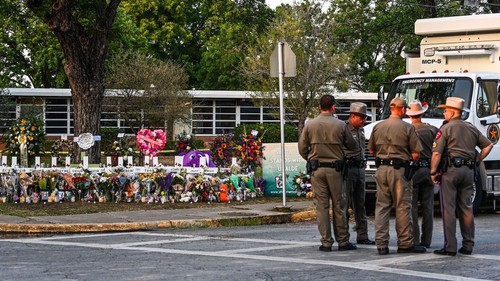Texas Cops Did The Opposite of Right, They Waited Outside Instead of Saving
 |
| TEXAS POLICE FACED ANGRY QUESTIONS MAY 26, 2022 OVER WHY IT TOOK AN HOUR TO NEUTRALIZE THE GUNMAN WHO MURDERED 19 SMALL CHILDREN AND TWO TEACHERS IN UVALDE, AS VIDEO EMERGED OF DESPERATE PARENTS BEGGING OFFICERS TO STORM THE SCHOOL. (PHOTO BY CHANDAN KHANNA/AFP VIA GETTY IMAGES) |
{VICE}
Elementary school children, locked into a classroom with a heavily-armed gunman, were risking their lives to call 911 and beg for help.
More than a dozen police officers were standing outside that classroom at Robb Elementary in Uvalde, Texas, as the scene unfolded early Tuesday afternoon. They knew that children were inside, with a heavily armed person, and that many had been shot. Instead of doing everything they could to gain entry to the classroom and save the children, they waited. For over an hour.
Texas Department of Public Safety Director Steve McCraw, appearing visibly shaken in a press conference Friday, confirmed the public’s worst fears about the massacre, which left 19 children and two adults dead.
“Over 400 rounds were pumped into those classrooms. All firing afterward was sporadic and at the door,” said McCraw. “The belief was there may not be anybody living anymore.”
Once the shooter was in the fourth-grade classroom (which was internally connected to another classroom), the on-scene commander downgraded the threat level from an “active shooter situation” to a “barricaded subject.” The shooter had “barricaded” himself in the room by simply locking the door. That decision was based on the assumption that there were “no more children at risk.”
For days, Texas officials have made vague statements and given unclear timelines about what exactly happened at Robb Elementary around midday Tuesday. They’ve attempted to spin the massacre into a law enforcement success story, repeatedly praising officers for their “heroic” and “courageous” actions. But the gaps in their timeline—specifically, the hourlong period where an armed assailant was inside the school—has come under increasing scrutiny every day since.
Now, McCraw is conceding that law enforcement may have made some grave errors.
"The decision was made on the scene that this was a barricaded subject situation and there was time to retrieve the keys and wait for a tactical team with the equipment to breach the door. That was the decision, that was the thought process at the time."
“It was the wrong decision,” McCraw said. “There's no excuse for that."
The shooter was barricaded into a classroom that was internally connected to a second classroom. Over a 40-minute period, several students locked in those rooms with the armed gunman called 911 and begged police for help.
Between 12:03 and 12:47 p.m., at least 10 calls were placed. One girl called 911 four times over a 16-minute period, between 12:03 and 12:16, speaking in whispers, saying which room she was in and saying that people had been killed.
Another girl called at 12:19 from the adjacent room, but another student told her to hang up. Another 911 call came from inside the classroom at 12:21, and at least three shots were heard being fired. At 12:36, another student called 911 from inside that adjacent classroom and stayed on the line for 21 minutes. She called back, and the operator told her to stay on the line and be quiet. She told 911 that the gunman had shot the door.
At 12:43 and at 12:47, she called again, asking 911 to “please send the police now.” McCraw said the last caller survived. When asked if the on-scene commander knew about those 911 calls, he said he would “not share the details right now” but added that that “question will be answered.”
McCraw, who at one point started crying during the press conference, would not apologize to the dead children’s parents for law enforcement’s “wrong decision”, saying it wouldn’t help anything. He called the situation “tragic.”
McCraw also helped clarify other murky details from law enforcement’s version of events. Public officials have given conflicting information about when and where officers came under fire, how many were wounded by gunfire, and which agencies those wounded officers were with.
Earlier this week, Gov. Greg Abbott said that three officers were injured by gunfire but in good condition. A representative from Texas Department of Public Safety said that a school resource officer attempted to prevent the gunman from entering the school, and was struck by gunfire. It turned out that the school resource officer in question was nowhere near the scene. Another official said that Uvalde police officers initially confronted the gunman inside the school, received gunfire, and pulled back.
Texas Rep. Tony Gonzales said that a lieutenant from Uvalde Police Department was shot during an exchange of gunfire by the classroom that the shooter eventually barricaded himself into. Officials have invoked these various and conflicting examples of police coming under fire to stress the dangerousness of the situation and justify the officers’ decision to wait for back-up.
McCraw clarified that two officers received “grazing wounds,” incurred as the shooter barricaded himself into the classroom. The third injured officer appears to be from Border Patrol; a bullet skimmed his scalp and he was treated for injuries at a hospital.
With files from Greg Walters
Comments